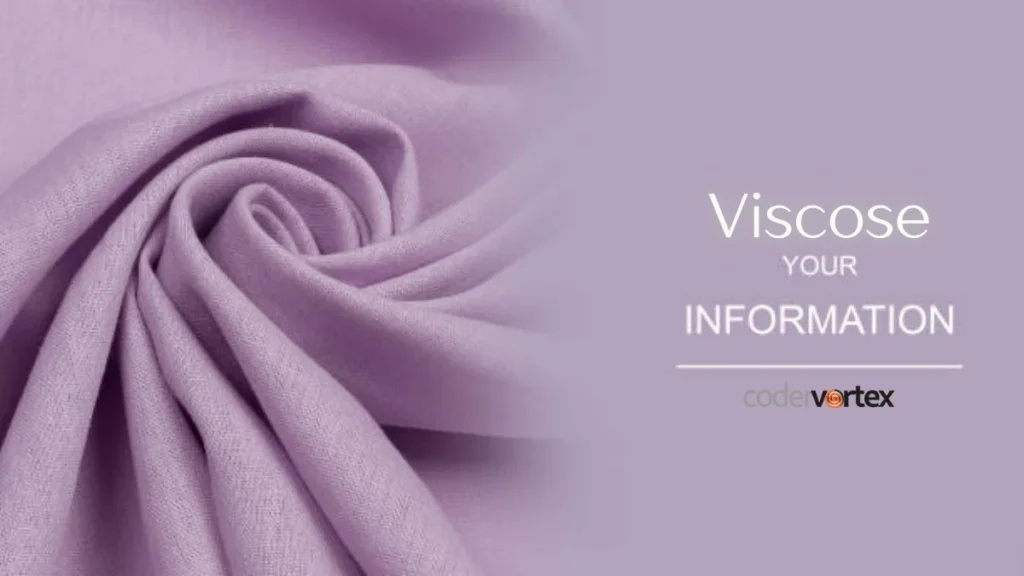ntroduction to Viscose
Viscose has become a popular choice in the textile world, but what exactly is it? As fashion enthusiasts and home decor aficionados seek versatile materials that combine comfort with style, viscose stands out as a top contender. This fabric’s silky texture and breathability make it an attractive option for clothing and interior design alike. But its journey from raw material to finished product is just as fascinating as its many uses. Let’s explore the ins and outs of viscose, uncovering why this fabric deserves a spot in your wardrobe and home collection.
What is Viscose Fabric?
Viscose fabric is a semi-synthetic textile made from cellulose, primarily sourced from wood pulp. This versatile material combines the natural feel of cotton with the luxurious drape of silk.
The process begins by dissolving cellulose to create a viscous solution, which is then spun into fibers. These fibers can be woven or knitted into various textiles suitable for clothing and home decor.
One of its standout features is its breathability, making it an excellent choice for warm weather apparel. Viscose also takes dye beautifully, resulting in vibrant colors that catch the eye.
Soft against the skin, it’s often used in blouses, dresses, and linings. Home furnishings benefit as well; think elegant curtains and soft upholstery fabrics that enhance any space’s aesthetic appeal.
The History and Production Process of Viscose
Viscose fabric has an intriguing history that dates back to the late 19th century. It was first developed in France as a silk substitute, offering a more affordable option for consumers.
The production process begins with cellulose, typically derived from wood pulp. This natural material is dissolved in chemicals to create a viscous solution. The term “viscose” actually comes from this thick liquid.
Once the solution is prepared, it’s extruded through spinnerets into acid baths. This transforms the viscous substance into solid fibers. These fibers are then washed and dried before being spun into yarn.
The result is a soft fabric that mimics silk but can be produced on a larger scale at lower costs. Over time, advancements have improved its manufacturing processes, increasing efficiency while maintaining quality.
Characteristics of Viscose Fabric
Viscose fabric stands out for its incredible softness. It drapes beautifully, making it ideal for elegant garments and flowing designs.
Breathability is another key trait of viscose. This feature keeps you comfortable in warmer weather, allowing air to circulate easily.
The fabric also boasts vibrant color retention. Viscose dyes exceptionally well, ensuring that your clothing maintains a rich hue even after multiple washes.
In addition to its aesthetic appeal, viscose has a luxurious feel similar to silk at a fraction of the cost. This quality makes it popular among fashion enthusiasts seeking affordability without sacrificing style.
Moreover, viscose has excellent moisture-wicking properties. It absorbs sweat efficiently, keeping you feeling fresh throughout the day while minimizing clinginess or discomfort during wear.
These characteristics make viscose a favored choice not just for clothing but also for home textiles like curtains and upholstery.
Benefits of Using Viscose in Clothing and Home Decor
Viscose offers a luxurious feel that elevates any clothing item. Its softness drapes beautifully, making it perfect for dresses, blouses, and even loungewear. The fabric’s breathable nature ensures comfort in various climates.
In home decor, viscose shines through elegant upholstery and stylish curtains. It adds a touch of sophistication while remaining easy to maintain.
One remarkable benefit is its ability to mimic more expensive fabrics like silk or wool at a fraction of the cost. This affordability allows you to indulge in high-end looks without breaking the bank.
Moreover, viscose holds vibrant dyes exceptionally well. This means your wardrobe or living space can showcase rich colors that last over time. Whether you’re dressing up or enhancing your home environment, viscose provides versatility that suits every taste and lifestyle.
Care and Maintenance Tips for Viscose Fabric
Caring for viscose fabric requires a gentle touch. Always check the care label first, as specific instructions can vary by manufacturer.
When washing, opt for cold water and a mild detergent. Handwashing is ideal to preserve softness and color vibrancy. If you choose to machine wash, use the delicate cycle.
Avoid wringing out viscose items; instead, gently squeeze out excess water. Air-dry them in a shaded spot, avoiding direct sunlight. This prevents fading and maintains their shape.
Ironing should be done on low heat with a cloth between the iron and fabric. This protects against scorching while keeping your garments looking fresh.
For stains, act quickly using cold water or specialized stain removers designed for delicate fabrics. Always test any treatment on an inconspicuous area first to prevent damage or discoloration.
Sustainable Alternatives to Traditional Viscose
As the demand for sustainable textiles rises, alternatives to traditional viscose are becoming more prominent. One notable option is Tencel, made from sustainably sourced wood pulp. It uses a closed-loop process that recycles water and solvents, minimizing environmental impact.
Another alternative is modal, which shares similarities with viscose but boasts improved durability and moisture-wicking properties. Modal production also often emphasizes eco-friendly practices.
Bamboo fabric has gained popularity as well. While not all bamboo fabrics are created equal, those produced through responsible methods can offer a softer feel along with biodegradability.
Lyocell represents an innovative step forward in fiber technology. This material utilizes less energy during production while maintaining the softness associated with viscose.
These sustainable options provide consumers with choices that align better with eco-conscious values without sacrificing comfort or style.
Conclusion
Viscose stands out as a remarkable fabric with its soft texture and versatility. It offers an appealing option for both clothing and home decor, making it a favorite among designers and consumers alike. Understanding the production process reveals just how intricate the journey of viscose is, from sourcing raw materials to creating beautiful textiles.
With characteristics like breathability, drape, and vibrant color retention, viscose provides comfort that’s hard to match. Its benefits extend beyond aesthetics; it’s often favored for its affordability compared to other luxurious fabrics. However, proper care is essential for maintaining its beauty over time. Simple washing guidelines can help preserve your cherished garments or home items made from this unique fiber.
As awareness about sustainability grows in the textile industry, exploring eco-friendly alternatives to traditional viscoses becomes crucial. Innovations are emerging that make it easier than ever to enjoy this lovely fabric while also being kinder to our planet.
Whether you’re looking to enhance your wardrobe or refresh your living space, incorporating viscoses into your choices can lead you toward stylish yet comfortable options that elevate any setting. Embracing such versatile fabric opens up endless possibilities in fashion and interior design.





